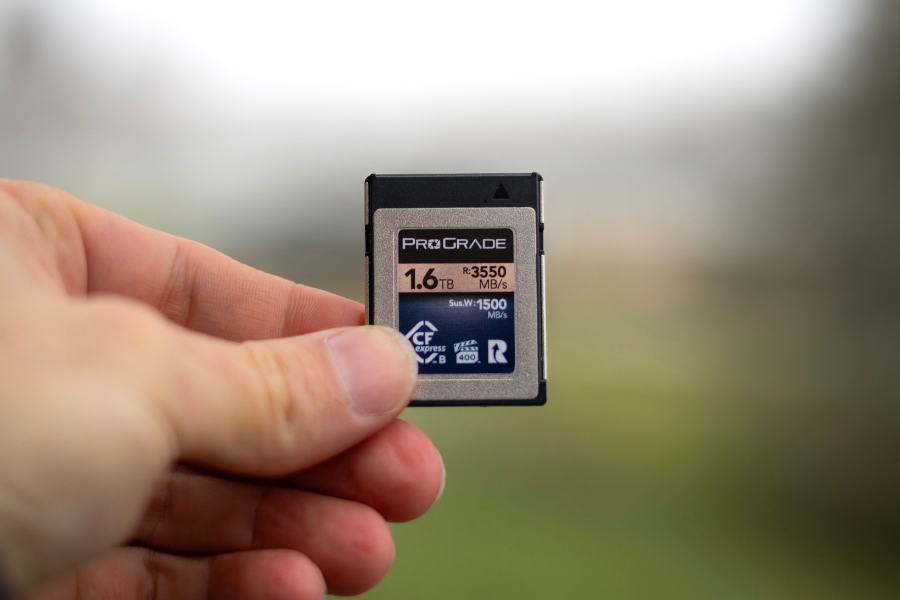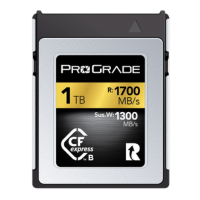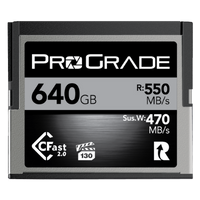Separating different types of memory cards—like distinguishing apples from oranges—is straightforward. However, making an educated choice among similar memory cards—akin to sorting oranges from oranges—can sometimes be challenging.
Just as finding the sweetest orange in a grove requires recognizing subtle differences in texture and hue, selecting the best memory card for your needs hinges on understanding critical variance in their capabilities.
Luckily, when it comes to memory cards, there is never any guesswork. That’s why memory cards come with specific markings, providing essential information about key performance indicators.
Understanding what all the symbols on the memory card mean allows you to pick the right card for your photography and videography needs with precision.
This guide is all about CFexpress memory cards. Here, we clarify the differences between Type A and Type B cards, explain what all the symbols on CFexpress cards mean, and discuss specialized features only some card manufacturers offer.
Type A vs. Type B CFexpress Cards
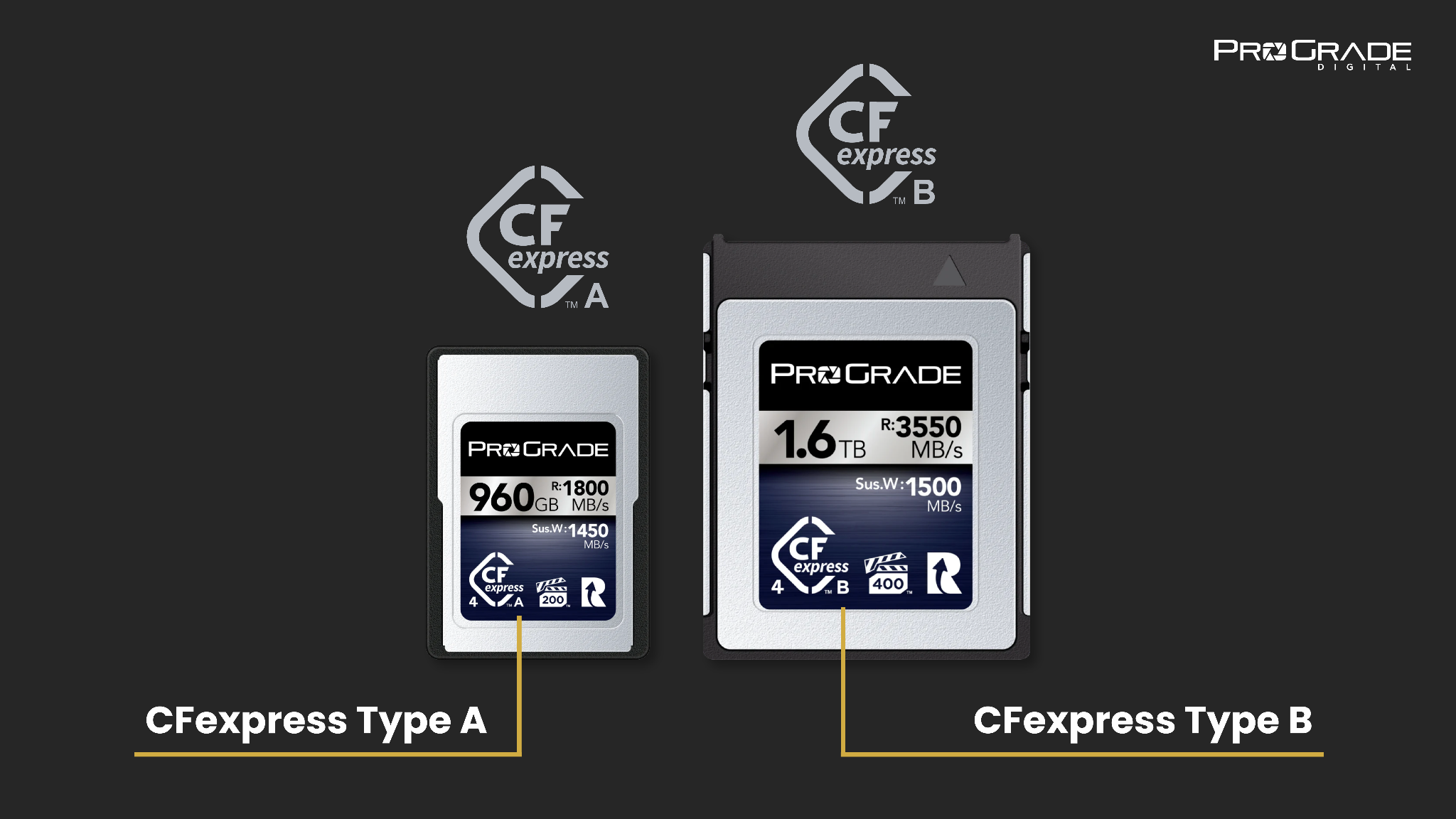
The CFexpress memory card family is distinguished by two primary form factors: Type A and Type B. These types are not performance indicators but rather size and compatibility specifications.
- CFexpress Type A – Type A cards are the smaller of the two form factors. This design caters to devices that require a compact memory card without compromising the high-speed capabilities essential for modern photography and videography.
- CFexpress Type B – In contrast, Type B cards are larger and designed for cameras that generally demand higher data processing capabilities. The larger form factor allows for enhanced technical features suitable for high-end photography and cinematic video recording equipment.
Despite their apparent size differences, each card type is distinctly marked to easily differentiate between the two: Type A cards have an ‘A’ printed next to the CFexpress logo on the right, while Type B cards feature a ‘B’ in the same location.
CFexpress 2.0 vs. CFexpress 4.0
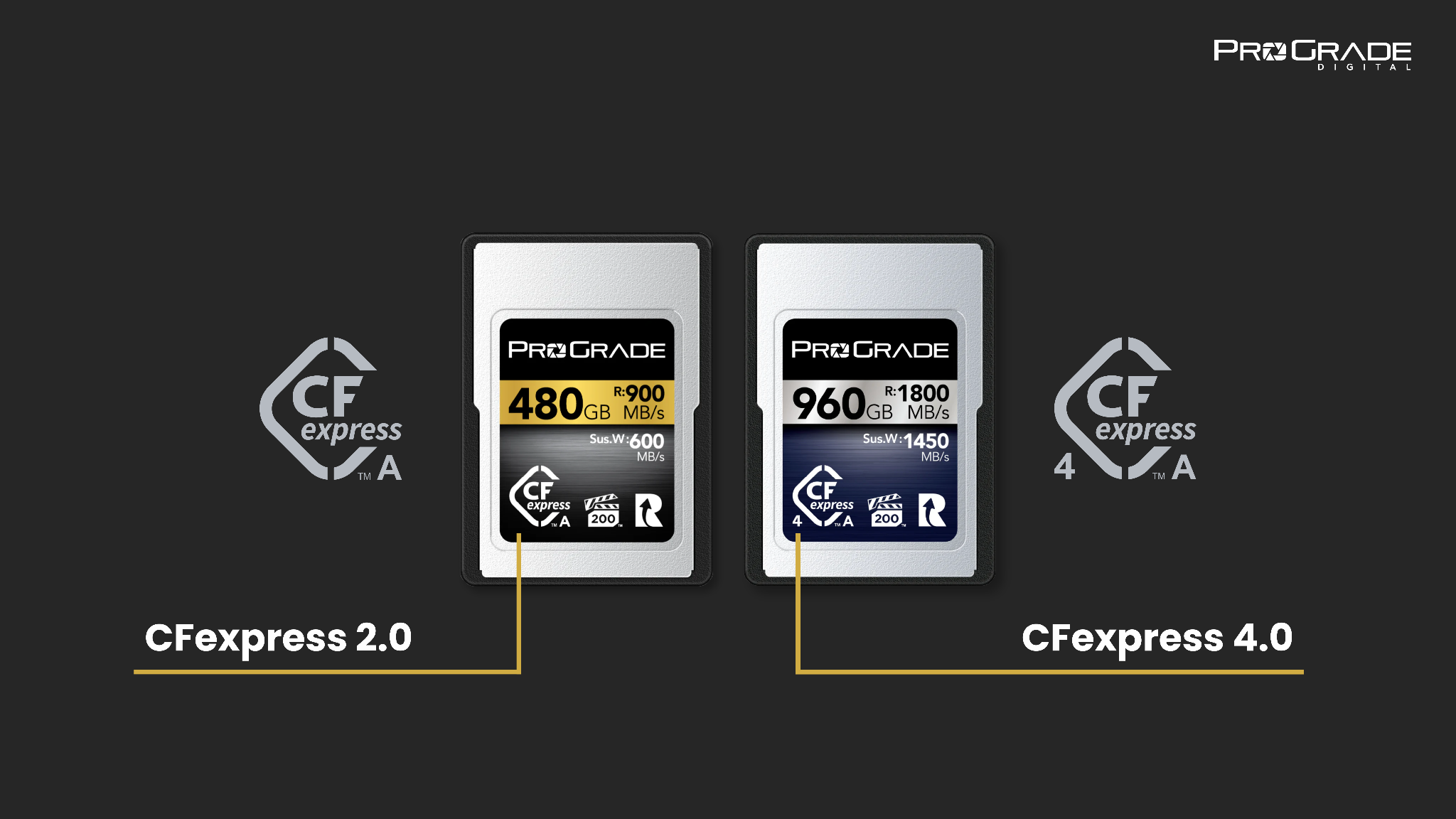
CFexpress has evolved significantly with the introduction of CFexpress 4.0, marking a notable advancement from the earlier 2.0 specification. Both iterations maintain the same physical form factors—Type A and Type B—but differ significantly in performance capabilities.
Advancements in CFexpress 4.0
By leveraging the latest technological standards, CFexpress 4.0 cards have dramatically enhanced their performance over their predecessors. They utilize the PCIe Gen4 interface coupled with the NVMe 1.4c specification, effectively doubling the maximum data transfer rates compared to CFexpress 2.0.
This upgrade means that Type A cards (the smaller of the two) can now achieve speeds that were previously only possible with Type B cards from the 2.0 series. At the same time, 4.0 Type B cards can now reach unprecedented speeds, significantly benefiting high-resolution video recording and rapid sequence photography in high-end cameras.
These enhancements not only promise improved efficiency in handling large files and higher frame rates but also ensure that CFexpress remains at the forefront of removable storage technology, particularly for demanding multimedia applications.
Identifying CFexpress 2.0 and 4.0
Differentiating between CFexpress 2.0 and 4.0 cards is straightforward, thanks to clear markings on the cards themselves. CFexpress 4.0 memory cards feature a prominent ‘4’ left to the CFexpress logo, making them easily identifiable. In contrast, CFexpress 2.0 cards have no marking, featuring only the standard CFexpress logo.
Capacity

Capacity is one of the most straightforward attributes marked on a memory card. Expressed in Gigabytes (GB) or Terabytes (TB), the capacity of a CFexpress card directly indicates the amount of storage space available. This is essential for planning how much content can be stored before needing to transfer data or replace the card.
Read Speed (R)

Read speed refers to how quickly data can be accessed and read from the card. It is typically measured in Megabytes per second (MB/s) and usually marked on the card by “R:” followed by a numerical value. A higher read speed means faster data transfer times from the card to a computer or other device. Faster speed is essential for efficiently importing large files, such as high-resolution photos or extensive video footage, reducing wait times and streamlining the post-production process.
Write Speed (W)
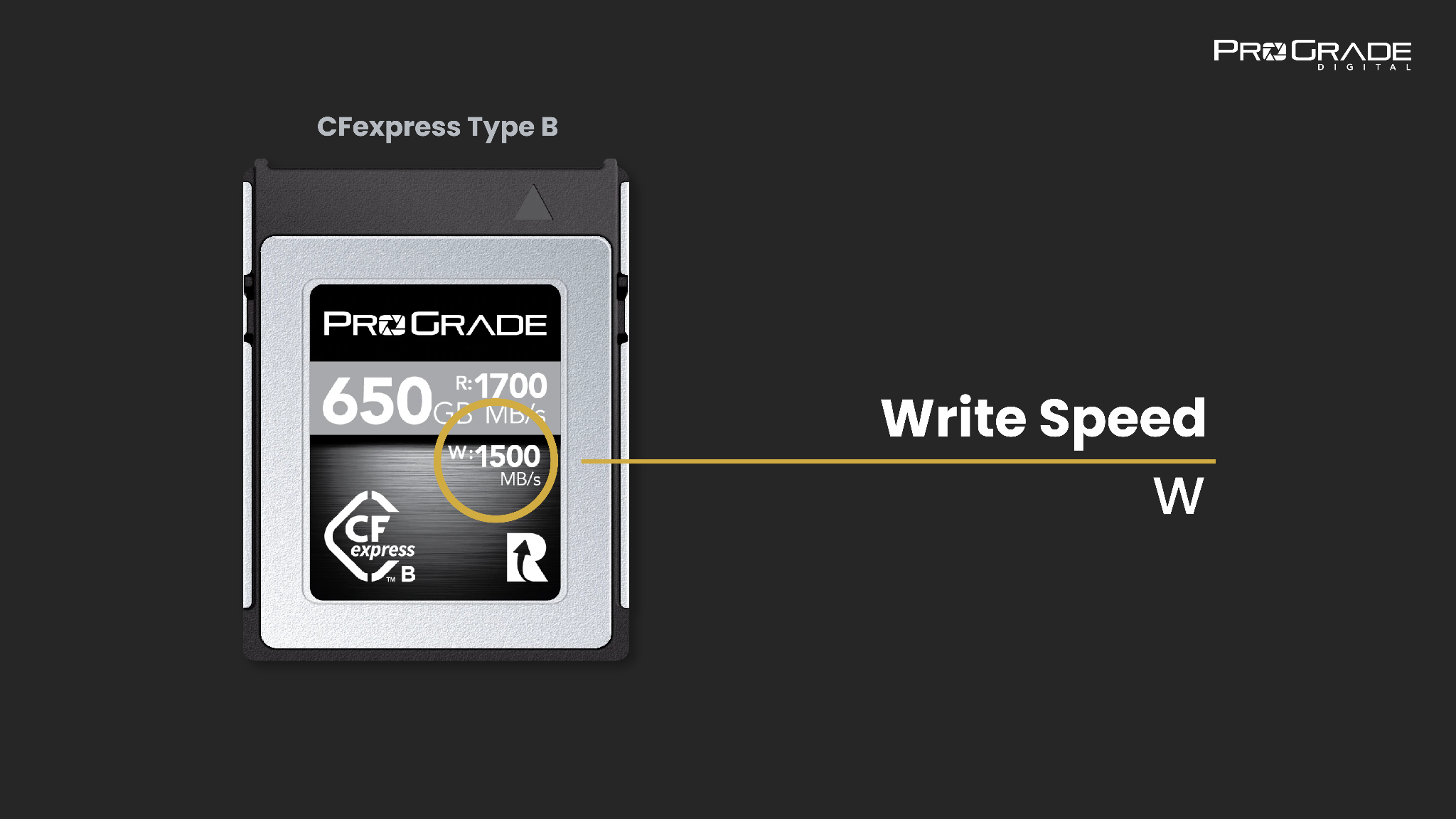
Similarly, write speed is indicated as “W:” followed by a number, showing the rate at which data can be written to the card, also in MB/s. A higher write speed ensures that the card can handle the influx of data without causing delays or errors, such as dropped frames in video recording.
Video Performance Guarantee (VPG) Rating of CFexpress Memory Cards
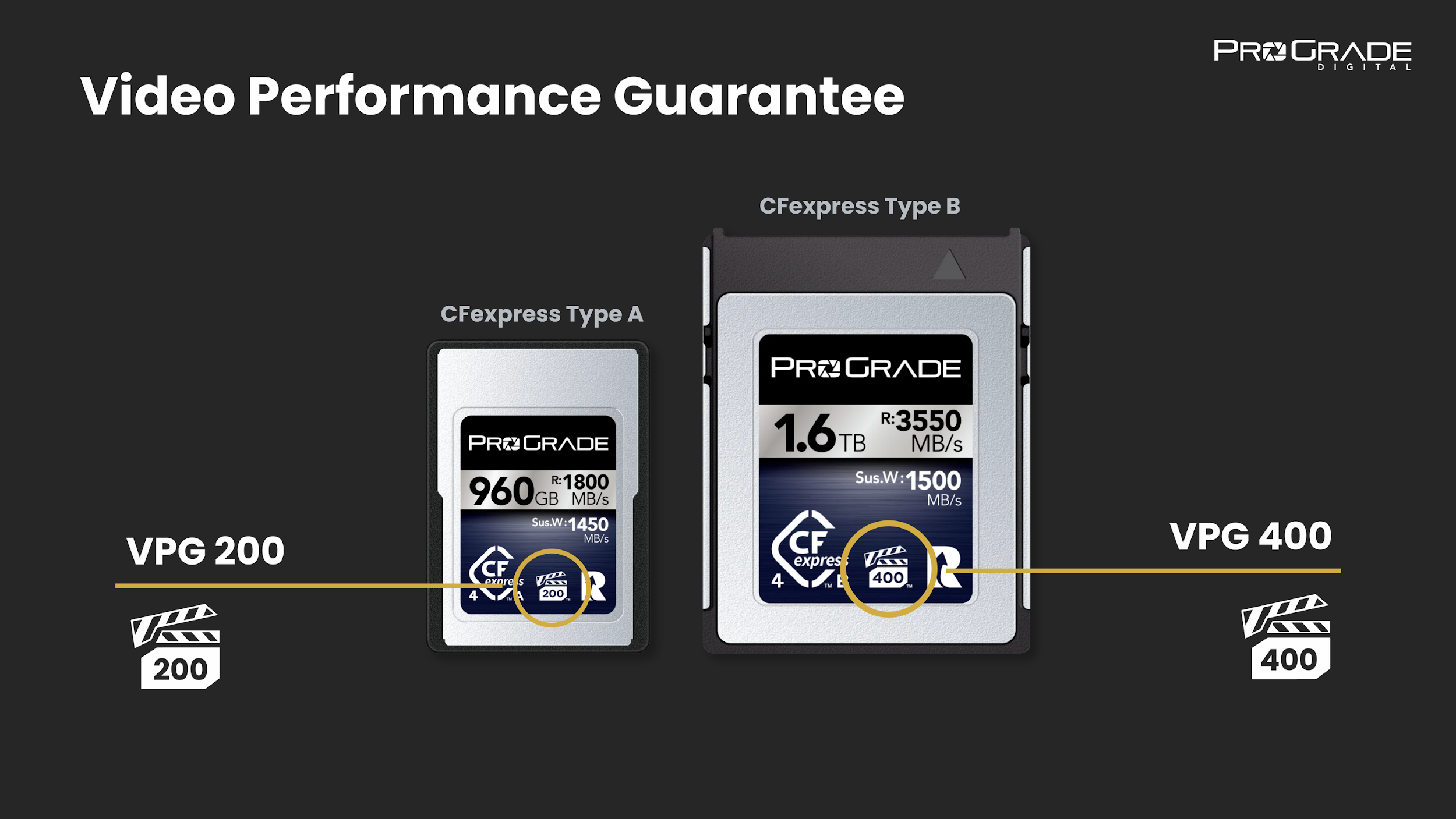
Video Performance Guarantee (VPG) ratings ensure that CFexpress cards meet specific minimum sustained write speeds, which are vital for recording high-resolution video without dropping frames.
VPG ratings are indicated by a number inside a clapperboard icon. This visual symbol represents the card’s guaranteed minimum write speed in megabytes per second.
- VPG 200: Cards with this marking guarantee a sustained write speed of at least 200 MB/s. This speed supports high-definition and 4K video recording at high frame rates.
- VPG 400: Cards marked with VPG 400 ensure a sustained write speed of at least 400 MB/s. This higher speed is essential for recording 8K video or 4K video at extremely high frame rates, accommodating the substantial data throughput required for such tasks.
The VPG rating is not just a guideline but a certified assurance. Cards undergo rigorous testing to ensure they consistently meet or exceed this speed, making them reliable for professional video production, where maintaining quality and continuity is non-negotiable. That said, it is by no means an indicator of a card’s actual capabilities, which brings us to the next topic—’actual‘ sustained write speed.
Sustained Write Speed (Sus. W)

As of now, the highest Video Performance Guarantee (VPG) rating memory cards can get certified for is VPG 400, which ensures that a card will not drop below 400 MB/s in sustained transfer speeds.
ProGrade Digital is the only manufacturer that indicates the sustained write speed on the label artwork for their CFexpress and CFast memory cards
For example, the ProGrade Digital CFexpress Type B 4.0 Cobalt memory card has a sustained write speed of 2,100MB/s. That means 2,1GB of data can be written continuously on the card, second after second.
The sustained write speed is marked on ProGrade Digital memory cards as “Sus. W:” followed by a numerical value in Megabytes per second (MB/s), providing users with a more precise understanding of the card’s performance capabilities under continuous high-demand usage.
Refresh Pro Compatibility Marking

ProGrade Digital CFexpress cards feature a unique ‘R’ logo with an arrow, indicating compatibility with Refresh Pro software. This software is designed to monitor the health of the card and refresh ProGrade Digital memory cards to their original factory-fresh condition. Using Refresh Pro helps maintain optimal performance and extend the card’s lifespan, ensuring it functions reliably for professional use. Refresh Pro allows you to effortlessly update the firmware on your ProGrade Digital memory card.
CFexpress Memory Card Guide: Final Words
And there you have it! Just like distinguishing the ripest orange from a sea of not-so-ripe ones, choosing the right CFexpress memory card can be quite a task. But now, armed with this guide, you’re well-equipped to navigate the subtle nuances of each card—turning a complex decision into an informed one.
If you’re curious about the markings on SD cards and how they can impact your shooting, you can dive deeper here: Symbols on SD Cards Explained.
Ready to explore the full lineup of ProGrade Digital CFexpress memory cards? Browse the selection here and find the perfect match for your high-resolution recording needs: ProGrade Digital Memory Cards.
